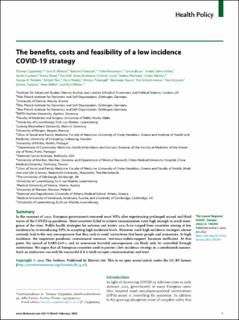| dc.contributor.author | Czypionka, Thomas | |
| dc.contributor.author | Iftekhar, Emil | |
| dc.contributor.author | Prainsack, Barbara | |
| dc.contributor.author | Priesemann, Viola | |
| dc.contributor.author | Bauer, Simon | |
| dc.contributor.author | Calero Valdez, Andre | |
| dc.contributor.author | Cuschieri, Sarah | |
| dc.contributor.author | Glaab, Enrico | |
| dc.contributor.author | Grill, Eva | |
| dc.contributor.author | Krutzinna, Jenny | |
| dc.contributor.author | Lionis, Christos | |
| dc.contributor.author | Machado, Helena | |
| dc.contributor.author | Martins, Carlos | |
| dc.contributor.author | Pavlakis, George | |
| dc.contributor.author | Perc, Matjaz | |
| dc.contributor.author | Petelos, Elena | |
| dc.contributor.author | Pickersgill, Martyn | |
| dc.contributor.author | Skupin, Alexander | |
| dc.contributor.author | Schernhammer, Eva | |
| dc.contributor.author | Szczurek, Ewa | |
| dc.contributor.author | Tsiodras, Sotirios | |
| dc.contributor.author | Willeit, Peter | |
| dc.contributor.author | Wilmes, Paul | |
| dc.date.accessioned | 2023-03-29T13:21:56Z | |
| dc.date.available | 2023-03-29T13:21:56Z | |
| dc.date.created | 2022-01-11T15:06:16Z | |
| dc.date.issued | 2022 | |
| dc.identifier.issn | 2666-7762 | |
| dc.identifier.uri | https://hdl.handle.net/11250/3060951 | |
| dc.description.abstract | In the summer of 2021, European governments removed most NPIs after experiencing prolonged second and third waves of the COVID-19 pandemic. Most countries failed to achieve immunization rates high enough to avoid resurgence of the virus. Public health strategies for autumn and winter 2021 have ranged from countries aiming at low incidence by re-introducing NPIs to accepting high incidence levels. However, such high incidence strategies almost certainly lead to the very consequences that they seek to avoid: restrictions that harm people and economies. At high incidence, the important pandemic containment measure ‘test-trace-isolate-support’ becomes inefficient. At that point, the spread of SARS-CoV-2 and its numerous harmful consequences can likely only be controlled through restrictions. We argue that all European countries need to pursue a low incidence strategy in a coordinated manner. Such an endeavour can only be successful if it is built on open communication and trust. | en_US |
| dc.language.iso | eng | en_US |
| dc.publisher | Elsevier | en_US |
| dc.relation.uri | https://www.thelancet.com/journals/lanepe/article/PIIS2666-7762(21)00280-5/fulltext | |
| dc.rights | Navngivelse 4.0 Internasjonal | * |
| dc.rights.uri | http://creativecommons.org/licenses/by/4.0/deed.no | * |
| dc.title | The benefits, costs and feasibility of a low incidence COVID-19 strategy | en_US |
| dc.type | Journal article | en_US |
| dc.type | Peer reviewed | en_US |
| dc.description.version | publishedVersion | en_US |
| dc.rights.holder | Copyright 2021 The Author(s) | en_US |
| dc.source.articlenumber | 100294 | en_US |
| cristin.ispublished | true | |
| cristin.fulltext | original | |
| cristin.qualitycode | 1 | |
| dc.identifier.doi | 10.1016/j.lanepe.2021.100294 | |
| dc.identifier.cristin | 1978552 | |
| dc.source.journal | The Lancet Regional Health - Europe | en_US |
| dc.relation.project | EC/H2020/724460 | en_US |
| dc.identifier.citation | The Lancet Regional Health - Europe. 2022, 13, 100294. | en_US |
| dc.source.volume | 13 | en_US |

